The pottery found by the Danish expedition is of interest for three main reasons. First, and primarily because of its connection with the Maussolleion, which provides a terminus ante quem. Maussollos is thought to have founded Halikarnassos no later than 367/366 BC, and the terrace and grave monument seem likely to have been part of the city plan from the very beginning [3]. The monument was probably nearly finished when Maussollos died in 353 BC, and must have been completed by Artemisia before her own death two years later. Secondly, because the ceramic finds potentially throw light on some of the activities in and about the Maussolleion terrace both before and after it was built. And thirdly, because the material provides a cross-section of pottery used in Halikarnassos from the Archaic through the Hellenistic periods - not least of a large group of local or near-regional plain wares, published for the first time.
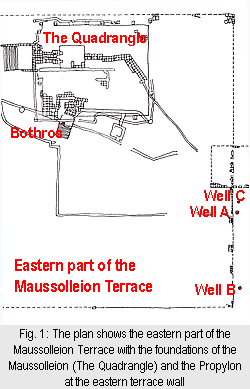 Only a few closed deposits (fig. 1) can be reliably related to the construction of the Maussolleion because of the disturbances that occurred when the area was extensively investigated by Charles Newton in the 1860s. One context (A) [4] is of particular interest: a Bothros hewn out in a staircase leading to a structure which has been interpreted as a Pre-Maussollan sanctuary or burial complex [5]. The pottery found in the Bothros seems to be linked with rituals performed in or around this structure. The abundance of vessels associated with drinking is noteworthy, as is the almost total absence of cooking wares and terracotta figurines. More than 75% of the fine wares were drinking vessels, and about 93% of the plain wares were associated with the pouring or storing of liquids, which makes it reasonable to suppose that the contents of the Bothros might have something to do with rituals performed when the complex was abolished to give way for the monument to come.
Only a few closed deposits (fig. 1) can be reliably related to the construction of the Maussolleion because of the disturbances that occurred when the area was extensively investigated by Charles Newton in the 1860s. One context (A) [4] is of particular interest: a Bothros hewn out in a staircase leading to a structure which has been interpreted as a Pre-Maussollan sanctuary or burial complex [5]. The pottery found in the Bothros seems to be linked with rituals performed in or around this structure. The abundance of vessels associated with drinking is noteworthy, as is the almost total absence of cooking wares and terracotta figurines. More than 75% of the fine wares were drinking vessels, and about 93% of the plain wares were associated with the pouring or storing of liquids, which makes it reasonable to suppose that the contents of the Bothros might have something to do with rituals performed when the complex was abolished to give way for the monument to come.In addition, the relationship between fine and coarse wares in the other Pre-Maussollan contexts (B-F) [6] also seems unusual in so far as the percentage of coarse wares is remarkably low, and the number of drinking vessels is much higher than the number of vessels for serving food. In this respect there is a marked difference from the Hellenistic fine wares of the site, where the relationship between drinking and eating vessels is fifty-fifty, much more in accordance with the living quarters of a town. This may indicate that the character of the neighbourhood could have changed during the course of the 3rd century BC.
Three wells, C, A and B (contexts G, H and I) [7], were found along the eastern terrace wall which was an integrated part of the Maussolleion complex. The proximity of the wells to the terrace wall led the excavators to suggest that they had been dug before it was built, and they regarded the filling of the wells as a consequence of its construction. However, our analysis suggested that they were dug at about the same time as the construction of the terrace wall, i.e. between ca. 365 and 353 BC. Well A was filled in two tempi: the first time about the middle of the 4th century BC or shortly thereafter, and again about 200 BC +/-25 years. A terminus post quem for the final filling is provided by the presence within it of a series of Rhodian stamped amphora handles dated between 247 and 231 BC. Well C seems to have been filled in for the first time in the second half of the 4th century BC, and again in the 3rd or 2nd centuries BC, judging by the date of the pottery found in the uppermost layer. The date of the first filling of Well B is less certain, but the upper filling seems to have taken place in the 2nd century BC.
It is possible that the digging of the wells was connected with the actual construction of the terrace and the building of the Maussolleion, which must have necessitated abundant amounts of water. Nor can the possibility be excluded that the wells played a role in the later rituals on the premises. The pottery found in the three wells consists primarily of local plain ware jugs and hydria, and of transport amphorae. Strikingly few fine wares were found, and cooking wares seem to be nearly absent. In Well A, nine near-complete Chian and at least one Koan wine amphorae were part of the lower fill. The original filling of the three wells seems to have been deliberate, and might have taken place at the same time - perhaps connected with activities taking place on the terrace.
No quantified assessment has been made of the estimated total of 120.000 pottery finds stored in the Maussolleion Museum, but it is probably not off the mark to suggest that most of the finds date from the 4th, the 3rd and perhaps also the 2nd centuries BC. Ceramic (and non-ceramic) material from the 6th century and most of the 5th century BC was very rare indeed, and pottery from the 1st century BC and the Roman and Late Antique periods seemed scarce.
In the 5th and early 4th century BC, there was a relatively sparse import from Athens, such as fine examples of red figure pottery and black gloss ware [8]. In the 4th century BC [9], the preponderance shifted [10] to a class we referred to as "Non-Attic black-gloss ware" [11]. Most of the black gloss material in the Bothros consists of cups of this ware. As the name subtly hints, this does not seem to originate in Attica, yet it has a close resemblance to Attic black gloss ware in fabric and forms. Its source area is unknown, but it seems likely that it should be sought in the Eastern Aegean.
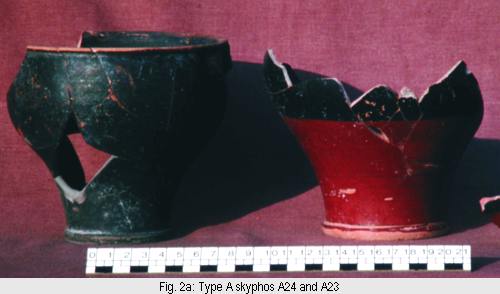
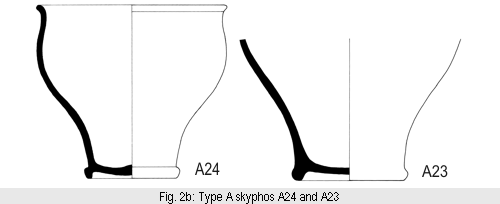
A photograph taken at the time of the excavation of Well A (context H) (fig. 6a) shows eight near-complete Chian transport amphorae (fig. 6b) flanked by two Koan amphorae, all part of the lowest fill of the well.
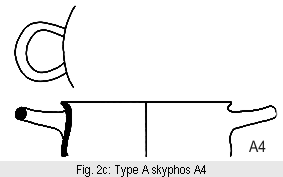 The type A skyphos (fig. 2a-b) was very commonly found in Pre-Maussollan contexts. The majority of these drinking cups are made in a Non-attic fabric, suggesting a regional source. A4 is the black gloss variant (fig. 2c), A23 a rare bichrome cup, and A24 the black-slipped version. Their shape indicates a date in the third quarter of the 4th century according to the current chronology; this chronology may now be adjusted to conform to the Maussolleion evidence, i.e. lowered a quarter of a century.
The type A skyphos (fig. 2a-b) was very commonly found in Pre-Maussollan contexts. The majority of these drinking cups are made in a Non-attic fabric, suggesting a regional source. A4 is the black gloss variant (fig. 2c), A23 a rare bichrome cup, and A24 the black-slipped version. Their shape indicates a date in the third quarter of the 4th century according to the current chronology; this chronology may now be adjusted to conform to the Maussolleion evidence, i.e. lowered a quarter of a century.
The Hellenistic fine ware pottery processed from the Maussolleion derives from two selected contexts. Context J has an end-accumulation towards the middle of the 2nd century B.C, Context K during the first quarter of the 1st century B.C. The material shows a rich range of Hellenistic pottery forms dating from the early 3rd century until the beginning of the 1st century. Indeed, a marked increase in the occurrence of black-slipped pottery of possibly Knidian origin is noticed as early as the early 3rd century. The major groups are West Slope decorated fine wares and so-called Megarian bowls, as well as undecorated plates and bowls, so-called Knidian bowls, unguentaria etc., showing a broad range of contemporary fabrics and forms from this period.
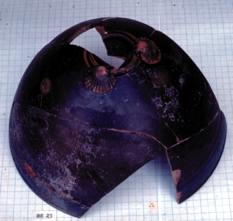
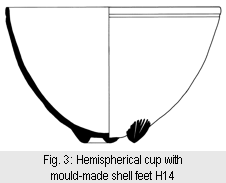 The bowl H14 (fig. 3) was found in the upper fill of Well A, and fragments of this bowl type have turned up in other contexts at the Mausolleion. The clay of the latter specimens appears to be Knidian. The type has also been identified in the city of Rhodes, and it is possible that the workshops in these two centres were part of a regional koiné of fine ware producers.
The bowl H14 (fig. 3) was found in the upper fill of Well A, and fragments of this bowl type have turned up in other contexts at the Mausolleion. The clay of the latter specimens appears to be Knidian. The type has also been identified in the city of Rhodes, and it is possible that the workshops in these two centres were part of a regional koiné of fine ware producers.
The largest group of plain wares from the 4th century BC consisted of a ware characterised by an abrasive and burnished surface, the so-called Red Burnished Ware, presumably made in a local workshop. The same fabric seems to have been used for cooking ware and Hellenistic brazier supports [12].
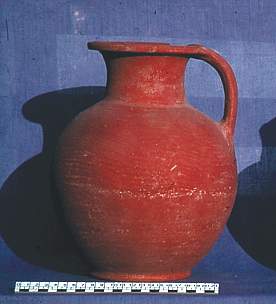
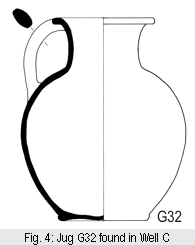 This type of jug (fig. 4) with a flat, raised base, ovoid body, concave neck with flaring rim and an oval handle is very common in the well material. It is burnished on the shoulder, rim, and handle. The fabric is very coarse, with a hackly break and numerous inclusions, including golden mica.
This type of jug (fig. 4) with a flat, raised base, ovoid body, concave neck with flaring rim and an oval handle is very common in the well material. It is burnished on the shoulder, rim, and handle. The fabric is very coarse, with a hackly break and numerous inclusions, including golden mica.
Another group of plain wares from the 4th century BC has been recognised as Knidian: namely a number of large pitchers produced in the Resadiye workshop and found in the Bothros and in Well C. These pitchers seem to go with shapes of the so-called yellow smoothened ware, and the identification of the workshop of the pitcher hints at the Knidian peninsula as the production centre of the entire group.
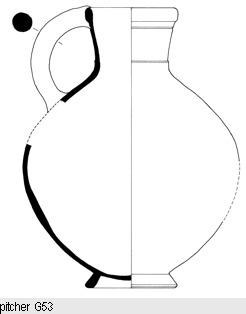
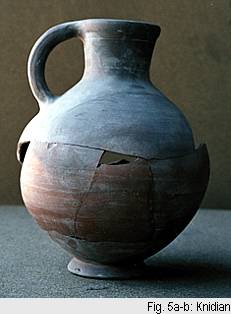 This kind of pitcher (fig. 5) with ring base, globular body, short conical neck and a high rim, almond-shaped in section, was found only in the Bothros and Well C. This could suggest a relatively short production period around the middle of the 4th century BC.
This kind of pitcher (fig. 5) with ring base, globular body, short conical neck and a high rim, almond-shaped in section, was found only in the Bothros and Well C. This could suggest a relatively short production period around the middle of the 4th century BC.
The transport amphorae from the Maussolleion suggest that the primary source of such imports in the 4th and 3rd centuries BC was near-regional wine-producing centres such as Kos and the Knidian peninsula [13]. However, wine was also imported from a greater distance in the 4th century BC: from Thasos - and possibly other Northern Greek centres - as well as Chios. Wine from these sources may have been regarded as a "luxury" of sorts. By the middle of the 3rd century BC, wine from Rhodes seems to have taken the place of those long-distance sources, without ousting the imports from Kos and Knidos. The Rhodian interest may have something to do with the fact that Halikarnassos had by then come under the Ptolemaic sphere of interest, and even though Rhodes was an independent state, the island was one of the most important trade partners of the rulers in Alexandria [14].
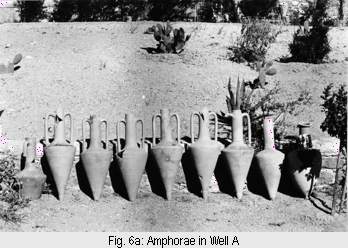
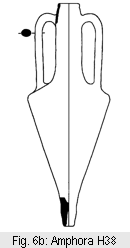
The ceramic finds from the Maussolleion excavations make it possible to obtain a first overall view of the pottery used in Halikarnassos during the reign of Maussollos and his successors until the conquest by Alexander. They reflect a thriving community with a local production of plain wares, and bespeak close connections with the surrounding region as well as with the Western and Northern Aegean. Our knowledge of the pottery repertoire in the Early Hellenistic period is less clear, but pottery from contexts datable to the Middle and Late Hellenistic periods was plentiful, mirroring a gradual change of the area of the Maussolleion from a unique burial site in the 4th century BC to that of a more conventional city centre in the Hellenistic period.
Bibliography of publications appearing since Vaag, L.E., Nørskov, V. and Lund, J. 2002, The Mausolleion at Halikarnassos. Reports of the Danish Archaeological Expedition to Bodrum, vol. 7. The Pottery. Ceramic Material and Other Finds from Selected Contexts. Aarhus:
Berlin, A.M. 2002, Ilion before Alexander: A Fourth Century B.C. Ritual Deposit, StTroica 12, 131-165.
Berlin, A.M. and Lynch, K. 2002, Going Greek: Attizising Pottery in the Achaemenid World, StTroica 12, 167-178.
Blondé, F. 2001, La céramique attique hellénistique à vernis noir: quelques commentaires sur les acquis récents et les problèmes', in Geny, E., Céramiques hellénistiques et romaines III. Paris, 31-55.
Briese, M.B. and Pedersen, P. 2003, Report of the Turkish-Danish Investigations in Ancient Halikarnassos (Bodrum) in 2000 and 2001, 20, Arastirma Sonuçlari Toplantisi 1. Cilt, 257-272.
Carstens, A.M. 2002, Tomb cult on the Halicarnassan Peninsula, AJA 3, 391-409.
Doksanalti, E. 2003, Knidos-Kap Krio Hellenistik Sarniç Buluntulari, in: Abadie-Reynal. C. (ed.), Les ceramiques en Anatolie aux époques hellenistiques et romaine. Actes de la Table Ronde d'Istanbul 23-24 mai 1996. Istanbul, 27-33.
Finkielsztejn, G. 2001, Politique et commerce à Rhodes au IIe siècle a.C.: le témoignage des exportations d'amphores, in: Bresson, A. and Descat, R. (eds.), Les cites d'Asie Mineure occidentale au IIe siècle a.C. Bordeaux, 181-196.
Lawall, M.L. 2002, Ilion before Alexander: Amphoras and Economic Archaeology, StTroica 12, 197-243.
Şahin, M. 2003, Hellenistische Kohlebecken. Kohlenbecken mit figürlich verzierten Attaschen aus Knidos. Frankfurt am Main.
Tezgör, D.K. 2003, La céramique fine de l'atelier A1 de Cnide, in: Abadie-Reynal. C. (ed.), Les ceramiques en Anatolie aux époques hellenistiques et romaine. Actes de la Table Ronde d'Istanbul 23-24 mai 1996. Istanbul, 35-43.
Trinkl, E. 2003, Griechische Töpfer in Kleinasien in klassischer Zeit - Die ephesische Evidenz, in: Schmaltz, B. and Söldner, M. (eds.), Griechische Keramik im kulturellen Kontext. Akten des Internationalen Vasen-Symposium in Kiel vom 24.-28.9. 2001. Münster, 74-76.
[1] Jeppesen, K., Højlund, F. & Aaris-Sørensen, K. 1981. The Maussolleion at Halikarnassos. Reports of the Danish Archaeological Expedition to Bodrum, vol. 1. The Sacrificial Deposit. Aarhus, 13-14. The most recent report on the ongoing work in Bodrum, see Briese and Pedersen 2003.
[2] Cf. Vaag, L.E., Nørskov, V. and Lund, J. 2002, The Maussolleion at Halikarnassos. Reports of the Danish Archaeological Expedition to Bodrum, vol. 7. The Pottery. Ceramic Material and Other Finds from Selected Contexts. Aarhus, 13-71 for a detailed discussion and bibliography of the ceramic wares identified. We take the opportunity here to refer to relevant publications, which appeared after it went into print.
[3] Pedersen, P. 1991, The Maussolleion at Halikarnassos. Reports of the Danish Archaeological Expedition to Bodrum, vol. 3.1. The Maussolleion Terrace and Accessory Structures. Aarhus, 95. Hornblower, S., Maussolos. Oxford 1982, 78-105. Hornblower places the synoikismos soon after Maussollos' accession in 377 BC, whereas Pedersen prefers a later date, in the early 360s BC.
[4] Vaag et al. 2002, 82-97.
[5] Zahle & Kjeldsen forthcoming, The Maussolleion at Halikarnassos. Reports of the Danish Archaeological Expedition to Bodrum, vol. 6. The Pre-Maussollan Structures. Aarhus. Carstens, A.M. 1999, Death Matters. Funerary Architecture on the Halikarnassos Peninsula. Unpublished PhD dissertation, University of Copenhagen, 107-113. Carstens 2002.
[6] Vaag et al. 2002, 98-129.
[7] Vaag et al. 2002, 130-182. For the terrace wall, see Pedersen 1991, 93. There was building rubble from the construction of the Maussolleion in the terrace filling.
[8] Vaag et al. 2002, 22-23; 30-33.
[9] Cf. Berlin 2002.
[10] Cf. Berlin and Lynch 2002.
[11] Cf. Trinkl 2003.
[12] Cf. Şahin 2003.
[13] Cf. Lawall 2002.
[14] Cf. Finkielsztejn 2001.
© Leif Erik Vaag, Vinnie Noerskov, John Lund
e-mail: klalev@hum.au.dk
klavn@mail.hum.au.dk
john.lund@natmus.dk
This article will be quoted by L.E. Vaag - V. Nørskov - J. Lund, Pottery from the Maussolleion at Halikarnassos, Forum Archaeologiae 28/IX/2003 (http://farch.net).